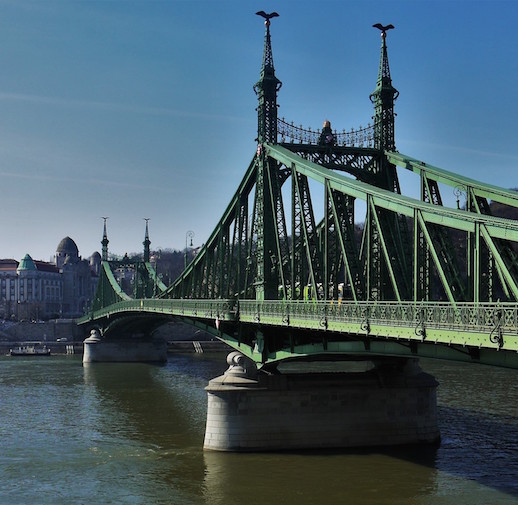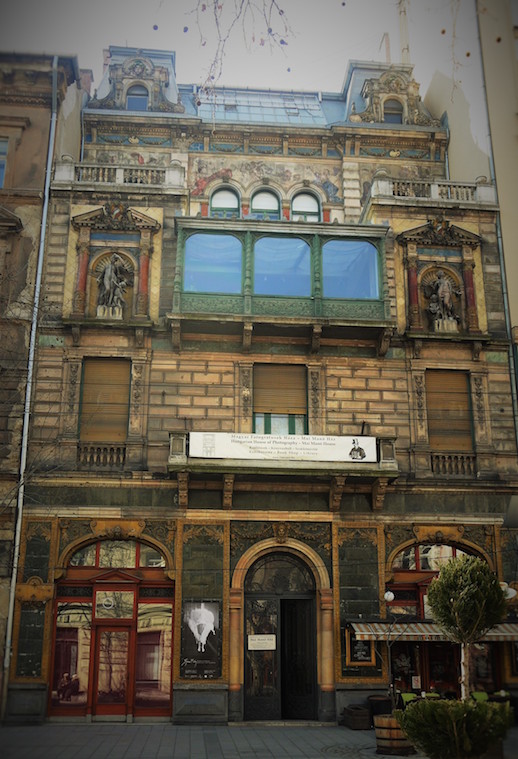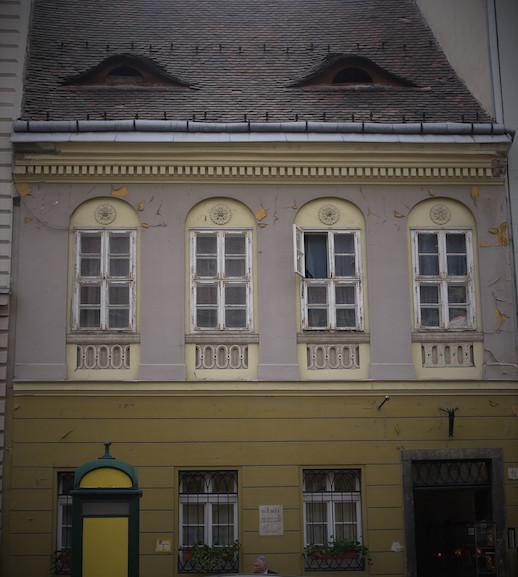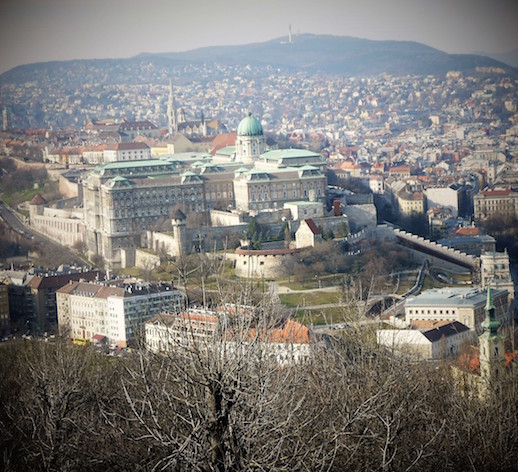 The Danube, Liberty Bridge and Gellert Spa
The Danube, Liberty Bridge and Gellert Spa
Words and pictures by Neil Sentance
Almost mandatory on a first visit to Hungary, the bowl of hot pungent goulash arrives at the table after a glass of Dreher beer has been downed. Gulyasleves is the stuff of the ancient Magyar kingdoms, originally a cattleman’s rich stew of meat and vegetables, ladled straight from vast iron cauldrons in encampments on the plains. The broth came to be spiced with paprika and sweet peppers, and over the years embellished by influences from other cultures, east and west. A dish for a Janus-faced city then, a city founded in the post-Roman vacuum by Uralic tribes, in a nation surrounded by Slavs and Germans. This kind of bounding ethnographic speculation was of course beloved of the writer Patrick Leigh Fermor, who at the midpoint of his legendary trek from Holland to Constantinople in 1934 stayed nearby to our cafe, in Uri utca (Gentleman Street), ‘a waving street of jutting windows, tiled roofs and arched doors with coats of arms’. Harboured in a book-filled house, his mornings were spent perched on a window-seat making his ‘fumbling assault’ on the intractable Magyar language and sipping Alka-Seltzers after his nights on the tiles over in Pest. Our soup warms and restores – with a nod to Paddy Leigh Fermor we order another beer and talk about the hard business of doing not much at all.
Alive to the spirit of Leigh Fermor we had crossed the broad Danube on a sun-filled early March morning via the Lanchid or Chain-Bridge. This graceful wrought iron and stone structure was the first permanent link between the two halves of this fissile city, built by Victorian British engineers for Count Szechenyi, Hungary’s great nineteenth-century moderniser. On the Buda side, the bridge is anchored near the restored funicular, little compartments of dark burnished wood and polished iron – you sit on a small bench, and out of the plate glass window take in the widening perspective of the river as you are hauled up the rockside. At the top we stepped off into the palace and fortress complex of the Var, the limestone plateau that dominates the skyline of the old city. Its vermiculated streets still follow their ancient course, all cobblestone and pantiles, a scene of picture-book Mitteleuropa. The Hungarians are great recorders – many houses display a stone plaque, a muemlek, detailing their history. We walked around following the scribing of history, all the layers partly effaced but still perceptible: medieval, Ottoman, Habsburg, and the wars and political tumults of the twentieth century. Fierce fighting in early 1945 between the holed-up Waffen-SS units and the rampaging Red Army left the Var in ruins. The locals cowered for weeks underground during the siege, a feral existence: we gaped into the maw of a cellar seen through holes in a rubbly wall in the Tarnok utca, its street-level masonry shell-pitted and crumbling. The hunched old people, hobbling to the supermarket on the paved streets, might have told us a shuddering tale. After the devastation of the Second World War, much of remnant castle district was demolished in the communist era, and many of the buildings here are reconstructions, some old re-pointed stone walls with concrete fascias or factory-made tiles.
Buda, as much as its conjoined sister across the river, lives with vivid encrustations of history on its spalled face. But the castle area retains its domesticity, with schools, homes and small cafes and general stores among the government blocks. The streets are quiet and under-lit, cars few, overflying aircraft nil. There are desultory tourists from Britain and Germany and some squawking Italian teenagers at Matyas Church, but overall there is a hushed quality, like an old country town, inspiring a reflective reverence for its long history. Leigh Fermor loved Buda’s silent walls and steep streets, its Dr Caligari slants and shades, the resonances of the city’s peculiar story. He would survey the river from the ramparts of the Fishermen’s Bastion before ‘rushing down full-tilt and haring across the Chain Bridge to Pest’, often to the fabled Arizona, ‘the scintillating cave of the most glamorous night-club I have ever seen’. Its revolving floor reputedly paraded horses, camels, even elephants, and ‘spangled acrobats’ and ‘human pagodas’, its gaudy rooms an effervescent confection, its chandeliers draped with gilded girls dangling upside-down … The building today houses a photography museum, but the part-coloured glass steps down to the basement promise a whiff of this pre-war wonder. Behind a screen we find a faded door, but sadly it is locked, and whatever remains of Paddy’s spectacular cabaret stays out of reach.
 The former home of the Arizona (‘the most glamorous nightclub I have ever seen’, Patrick Leigh Fermor)
The former home of the Arizona (‘the most glamorous nightclub I have ever seen’, Patrick Leigh Fermor)
Leaving the Var through a modest side-gate, we descend into Víziváros (Watertown), once inhabited by Danube fishermen and artisans, now a gentrifying district of stepped alleyways, schools and sturdy blocks of nineteenth-century flats angularly built into the hillside. This afternoon it is a place of fugitive light and fleeting cloud, old gas-lamps flickering as the sun goes down over the Var. We stop at a café, leg-weary, and drink another of the coffees that Budapestis excel in brewing. We talk of Antal Szerb, author of the enchanting Journey by Moonlight from 1937, a true polymath and one of the great European writers of the interwar period. Jewish by heritage though Catholic by upbringing, he’d been killed by the Nazis in a labour camp near the end of the war. The moral contamination of those years still hangs heavy in modern Hungarian consciousness. At nearby Szilagyi Dezso ter in 1945 the fascist Arrow Cross lined up Jewish men, women and children alongside the banks of the Danube before massacring them all, another in a rush of atrocities that marked the late-consigned Budapest holocaust. Leigh Fermor writes little about the darkening political and social forces he must have witnessed before the war. At one point in Between the Woods and the Water, he tells of his agreeable encounter with Pal Teleki, once and future premier of Hungary, who would later play a game of brinkmanship with the anti-Semites and Axis supporters and end up killing himself early in the war, unreconciled with the country’s role in the unfolding terror and yet complicit in it. It is nearly dark when we leave the bright lights of the café and hurry back to the Chain Bridge.
Another day, another Fermoresque hangover from the last night’s pálinka, and we set off for the west bank of the river again. A pair of jackdaws rise from the spars on the Elisabeth Bridge, the shortest of Budapest’s crossings over the swirling Danube. Rebuilt in the early 1960s after the original had been destroyed by the retreating Wehrmacht in 1945, we walk its elegant length, its slender lines of white cables leading the eye to the colossal foot of Gellért Hill. This rugged mound of dolomite rises 420 feet above the river embankment. Parents with youngsters are on their Sunday morning constitutionals, passing us as we struggle up the thin paths. The exercise is doing us good, but my legs feel like last year’s rhubarb. We reach the Liberation Monument, a bronze female figure holding a palm leaf 100 feet in the air. The locals call it ‘The Bottle-opener’, but as with much of the public art in the city it has been co-opted at various times by both Left and Right in the metropolitan storytelling. Behind the monument is the Cittadella, a stolid Habsburg era fortification, and from its walls we look out on the impressive panorama we had sweated up the hill for: the Pest waterfront, the caudal route of the Danube, the hazy Buda hills and the beginnings of the Great Plain, the Nagy Alföld. And in the near view are the Art Nouveau thermal baths of the Gellért hotel where we later take the waters in pools decorated in classical style with majolica tiles, ornate mosaics and lion-headed nozzles, a good place to soothe our thick heads.
The area around Gellért Hill is the Tabán, an old Serb and Ottoman area cleared of its stews and slums around the time that Paddy Leigh Fermor was here. Here there is a relic of the Turkish era, another mineral spa, the Rudas Baths, including a spectacular octagonal pool from 1556. Shafts of light from asterisk-shaped coloured glass apertures in the domed ceiling only dimly illuminate the stone pillars and circuit of hot and cooler baths. On our visit here old men wallow in quiet contemplation or animated discussion. Paddy would have had a piquant foretaste of his destination in these magical oriental halls. After ten days he left Budapest, and another of his riverside girlfriends, to cross the Alföld on horseback, en route to Transylvania and into greater Romania. For us, it is another soup of the day at the Ferihegy airport and the flight back to the rainy southwest of England.

